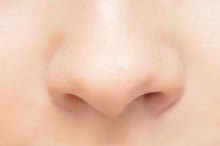What Is a Nasal Bone Spur?
Bone spurs, also called osteophytes, are extra bone growth along natural, pre-existing bones. Nasal bone spurs are when these bony growths develop in the nasal cavity or nose.
If you are experiencing serious medical symptoms, seek emergency treatment immediately.
If the body senses that there is any kind of weakened condition, it attempts to repair itself. When this is associated with the bones, bone spurs occur. This is caused by many different medical conditions. It is also caused by regularly occurring pressure or that is applied to an area near the bone. Any kind of stress to a bone area can cause a bone spur.
Sometimes when a nose bone is fractured or broken, a bone spur will grow during the healing process.
Location
Bone spurs occur along the floor of the nasal cavity. The maxillary crest, which runs along the middle of the floor of the nose, is also a location that nasal bone spurs often develop.
Deviated Septum
Bump on the Inside of the Nose
Learn More
Often a deviated septum is the cause of the excess bone growth. This may be because of the pressure that the septum that is off center is causing to the area of the bone in the nose that is being pressed against by the deviated septum. Various forms of injury that have nudged the cartilage out of place sometimes cause a deviated septum. In this instance the nasal bone spur may begin developing when the body is initially attempting to heal itself.
A bone spur may also be the cause to the septum being pushed off center.
- Often a deviated septum is the cause of the excess bone growth.
- A bone spur may also be the cause to the septum being pushed off center.
Effects
Nasal bone spurs sometimes go unnoticed and undiagnosed. Bone spurs may sometimes cause nosebleeds or nasal-airway obstruction. This can lead to difficulty breathing.
Nasal bone spurs can create severe headaches. Headaches that are caused by bone spurs may be diagnosed as migraines prior to the discovery of the excess bone growth.
Nasal bone spurs may touch or poke into the sides of the naval cavity. Nasal bone spurs also cause pain when this is the case.
Sometimes nasal bone spurs can be the cause of sinus pain.
- Nasal bone spurs sometimes go unnoticed and undiagnosed.
- Bone spurs may sometimes cause nosebleeds or nasal-airway obstruction.
Specialist
Complications of Nasal Polyp Surgery
Learn More
A nasal bone spur is often diagnosed and treated by an ear, nose and throat specialist (ENT). A general practice physician may be able to diagnose and treat nasal bone spurs, however, these cases are typically referred to the ENT specialist.
Treatment
If the nasal bone spurs are causing any negative effects, they may need to be treated. The grafting or removing of the additional and potentially sharp and poking bone protruding from the nasal bone is the treatment method for nasal bone spurs.
Related Articles
References
Writer Bio
Alicia Crowder is a full-time freelance writer. Her portfolio includes work for Free Press Houston, Nevermore magazine, Public News and online content. She has published one non-fiction book and written book reviews for multiple sites. Crowder also has experience as a technical writer of construction project specifications and computer software user manuals.





